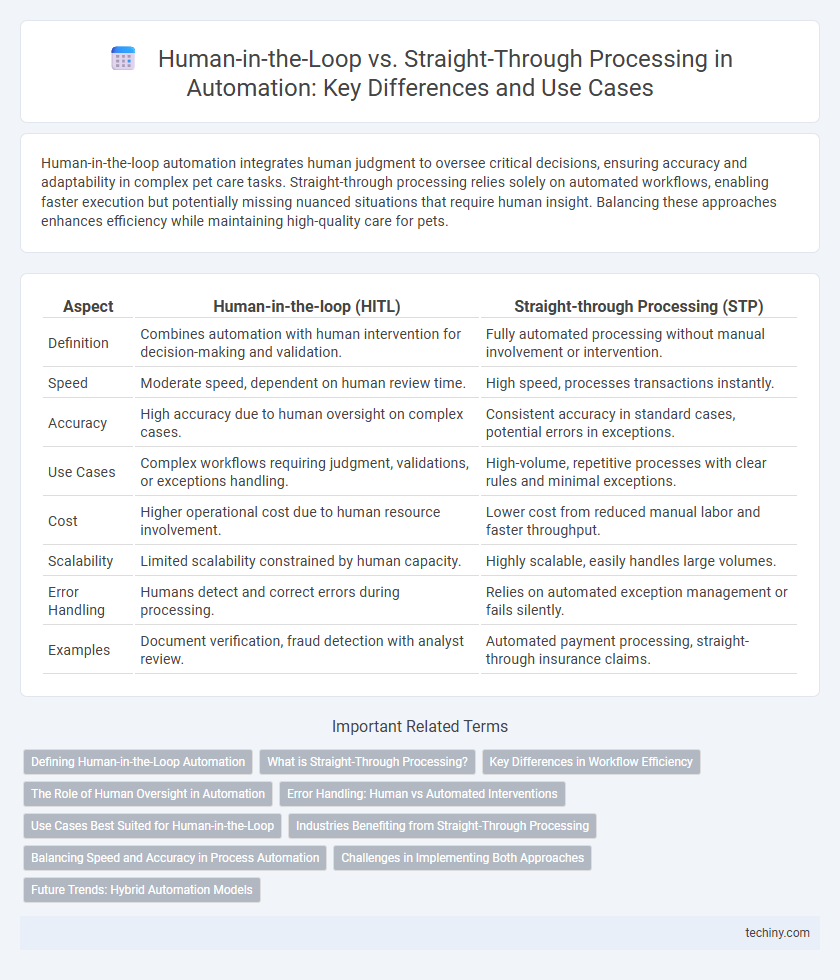Human-in-the-loop automation integrates human judgment to oversee critical decisions, ensuring accuracy and adaptability in complex pet care tasks. Straight-through processing relies solely on automated workflows, enabling faster execution but potentially missing nuanced situations that require human insight. Balancing these approaches enhances efficiency while maintaining high-quality care for pets.
Table of Comparison
| Aspect | Human-in-the-loop (HITL) | Straight-through Processing (STP) |
|---|---|---|
| Definition | Combines automation with human intervention for decision-making and validation. | Fully automated processing without manual involvement or intervention. |
| Speed | Moderate speed, dependent on human review time. | High speed, processes transactions instantly. |
| Accuracy | High accuracy due to human oversight on complex cases. | Consistent accuracy in standard cases, potential errors in exceptions. |
| Use Cases | Complex workflows requiring judgment, validations, or exceptions handling. | High-volume, repetitive processes with clear rules and minimal exceptions. |
| Cost | Higher operational cost due to human resource involvement. | Lower cost from reduced manual labor and faster throughput. |
| Scalability | Limited scalability constrained by human capacity. | Highly scalable, easily handles large volumes. |
| Error Handling | Humans detect and correct errors during processing. | Relies on automated exception management or fails silently. |
| Examples | Document verification, fraud detection with analyst review. | Automated payment processing, straight-through insurance claims. |
Defining Human-in-the-Loop Automation
Human-in-the-loop automation integrates human judgment within automated workflows to enhance decision-making accuracy and handle exceptions. This approach contrasts with straight-through processing, which relies entirely on automated systems without human intervention. Incorporating human oversight ensures higher-quality outcomes in complex or ambiguous tasks by combining AI efficiency with human expertise.
What is Straight-Through Processing?
Straight-through processing (STP) automates the complete execution of transactions or workflows without manual intervention, ensuring faster and error-free processing. It is widely used in financial services, insurance, and supply chain management to streamline operations and reduce costs. STP relies on integrated software systems and standardized data formats to enable seamless end-to-end automation.
Key Differences in Workflow Efficiency
Human-in-the-loop automation integrates human judgment at critical decision points, enhancing accuracy but often slowing workflow efficiency due to manual interventions. Straight-through processing (STP) automates the entire transaction flow without human input, significantly increasing speed and throughput but potentially sacrificing error handling precision. Workflow efficiency is highest in STP systems when processes are predictable and data quality is high, while human-in-the-loop systems excel in complex scenarios requiring nuanced evaluation.
The Role of Human Oversight in Automation
Human oversight plays a crucial role in automation by ensuring accuracy and mitigating risks through continuous monitoring and intervention. In Human-in-the-loop systems, human judgment is integrated with automated processes to handle exceptions and complex decision-making scenarios that algorithms may not fully address. This oversight enhances reliability and trust compared to Straight-through Processing, where automation operates without manual intervention, potentially increasing error risks in dynamic environments.
Error Handling: Human vs Automated Interventions
Human-in-the-loop automation integrates manual oversight to catch and correct errors that automated systems might miss, enhancing overall accuracy and reducing risk in complex decision-making processes. Straight-through processing (STP) relies solely on automated workflows, which minimizes human intervention but can result in unhandled errors or misinterpretations when unexpected conditions occur. Error handling in human-in-the-loop systems benefits from contextual judgment and adaptability, whereas STP depends on predefined rules and exception management protocols to address anomalies.
Use Cases Best Suited for Human-in-the-Loop
Human-in-the-loop automation excels in use cases requiring complex decision-making, such as fraud detection, medical diagnosis, and customer service escalation, where nuanced judgment and contextual understanding are critical. It enhances accuracy by integrating human expertise with AI, particularly in scenarios involving ambiguous data or evolving regulations. Industries like finance, healthcare, and legal services benefit from this approach, ensuring compliance and minimizing risks associated with fully automated processes.
Industries Benefiting from Straight-Through Processing
Industries such as finance, insurance, and telecommunications benefit significantly from straight-through processing by automating transaction workflows, reducing manual errors, and accelerating processing times. Straight-through processing enhances operational efficiency in high-volume environments like payment processing, claims adjudication, and customer onboarding by enabling seamless end-to-end automation without human intervention. This approach is critical for businesses aiming to improve scalability, compliance, and customer satisfaction through faster, error-free processing capabilities.
Balancing Speed and Accuracy in Process Automation
Human-in-the-loop systems enhance process accuracy by incorporating real-time human judgment, reducing errors in complex automation tasks. Straight-through processing maximizes operational speed by enabling end-to-end automation without manual intervention, ideal for high-volume, low-complexity workflows. Balancing speed and accuracy requires selectively integrating human oversight where decision complexity and error risk demand it, while leveraging straight-through processing for routine, predictable processes.
Challenges in Implementing Both Approaches
Human-in-the-loop systems face challenges such as increased processing time, potential for human error, and higher operational costs due to constant human intervention. Straight-through Processing struggles with handling exceptions and complex decision-making scenarios that require nuanced judgment, leading to potential inaccuracies or system failures. Both approaches demand robust integration with existing workflows and pose difficulties in balancing efficiency, accuracy, and scalability in automated processes.
Future Trends: Hybrid Automation Models
Future trends in automation emphasize hybrid automation models combining human-in-the-loop (HITL) systems with straight-through processing (STP) to optimize efficiency and accuracy. These models leverage artificial intelligence to handle high-volume, repetitive tasks while incorporating human judgment for complex decision-making and exceptions. Advancements in machine learning and real-time analytics are driving this integration, enabling scalable, adaptive workflows across industries.
Human-in-the-loop vs Straight-through Processing Infographic

 techiny.com
techiny.com